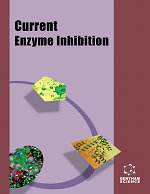- Home
- A-Z Publications
- Current Enzyme Inhibition
- Previous Issues
- Volume 20, Issue 3, 2024
Current Enzyme Inhibition - Volume 20, Issue 3, 2024
Volume 20, Issue 3, 2024
-
-
New Aspects in the Mechanism of Action of 3-hydroxy-3-methylglutaryl-COA Reductase (HMG-CoA reductase): Cyclic Lactones - Potential Inhibitors of the Enzyme (Review)
More LessAuthors: D.I. Boyarintsev, I.V. Kuzminov and M.V. OrlovaThe aim is to systematize data from literature sources on the study of changes in the activity of HMGR enzymes and lipid metabolism under the influence of cyclic lactones, identify among them new potential inhibitors of HMGR and formulate hypotheses about the details of the mechanism of action of the enzyme in relation to the product - mevalonolactone.
-
-
-
The Transformative Potential of Oxidoreductases in Pollutant Remediation – A Review
More LessAuthors: Asia Khalil, Ayman Iqbal, Muhammad Aqib Shabir, Ammarah Hasnain and Zainab NiazIn this modern era, the environment is being contaminated with toxic pollutants as a result of anthropogenic activities. To overcome the harmful effects of pollutants, scientists have developed ideas and technologies. Biotechnology provides a green approach for decontaminating the environment, i.e., bioremediation. Several organisms have been explored for their enzymes. Enzymes belonging to various classes are u Read More
-
-
-
Apocynaceae as a Potential Source for Acetylcholinesterase Inhibition in Symptomatic Regulation and Management of Alzheimer's Disease
More LessAuthors: Priyanka Kumari, Naveen Sarwa, Deepak Meena, Ajaya Eesha and Navneet Singh ChaudharyMemory loss or dementia is the key symptom of Alzheimer's disease (AD). In AD, significant interference in a progressive manner is observed in memory, behaviour, and cognitive abilities that affect the daily life of a person. At present, more than 50 million people are affected worldwide with Alzheimer's disease. Urgent attention is needed for the symptomatic regulation and management of this disease. The significant pharm Read More
-
-
-
In silico, In vitro, and In vivo Evaluation of the Anti-alzheimer’s Activity of Berberine
More LessBackground Alzheimer’s disease (AD), a progressive neurodegenerative disease for which there is no effective cure is among the leading causes of death worldwide. Objectives To investigate the potential anti-AD activity of berberine (BBR). Methods In silico assessment included molecular docking and ADMET prediction. BBR’s in vitro inhibitory activity of the target selected from docking results was assessed via colorimetric Read More
-
Volumes & issues
-
Volume 20 (2024)
-
Volume 19 (2023)
-
Volume 18 (2022)
-
Volume 17 (2021)
-
Volume 16 (2020)
-
Volume 15 (2019)
-
Volume 14 (2018)
-
Volume 13 (2017)
-
Volume 12 (2016)
-
Volume 11 (2015)
-
Volume 10 (2014)
-
Volume 9 (2013)
-
Volume 8 (2012)
-
Volume 7 (2011)
-
Volume 6 (2010)
-
Volume 5 (2009)
-
Volume 4 (2008)
-
Volume 3 (2007)
-
Volume 2 (2006)
-
Volume 1 (2005)
Most Read This Month
Article
content/journals/cei
Journal
10
5
false
en


